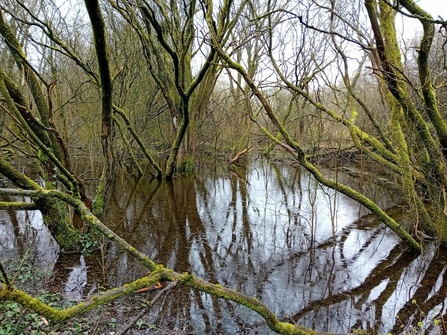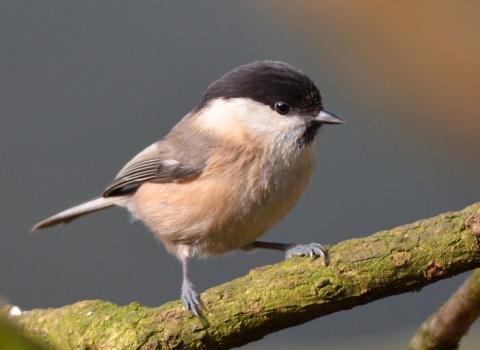Here we answer some of the most commonly asked questions about our Wet Willow Wildlife project, which is part of our biggest-ever appeal, Step up for Wildlife. We are raising funds for this project as part of Big Give's Green Match Fund 2024.
Big Give 2024 - Wet Willow Wildlife project (https://www.youtube.com/watch?v=F4AA4iKCrpM)
Jo Kennedy, Head of Landscape Nature Recovery, tells us more about the Wet Willow Wildlife project
Frequently Asked Questions
What is the Wet Willow Wildlife project?
The Wet Willow Wildlife project will play a crucial role in our conservation efforts for birds, butterflies, insects and amphibians. By creating natural corridors for wildlife to move freely and away from danger, and enhancing important habitats across key sites around the North West, we'll not only be supporting wet willow wildlife species but also promoting biodiversity and ecological resilience in our region.
Here are some of the main aims of the Wet Willow Wildlife project:
Habitat restoration: The project focuses on restoring wet willow habitats across 27 sites in Trafford, Mersey Gateway, Mosslands, and Bolton, which are crucial for the survival of wet willow wildlife species.
Habitat connectivity: By strategically creating and restoring habitat pockets connected by linking habitats, the project aims to improve habitat connectivity for wet willow species, allowing for greater movement and dispersal.
Community engagement: The project includes a comprehensive community engagement strategy, involving citizen science surveys, habitat volunteer programmes, community partnerships, and community events to raise awareness and involve local communities in our conservation efforts.
Species conservation: The project aims to benefit a range of species, including the willow tit, which is currently under threat. By providing suitable habitat and enhancing connectivity, the project contributes to the conservation and recovery of these threatened species.
Capacity building: The project provides opportunities for skills development and capacity building through practical conservation activities, volunteer programmes, and training initiatives, empowering local communities to actively participate in habitat restoration and conservation.
Every donation made to our project through The Big Give will be matched up to £10,000!
How does this project fit into your Step up for Wildlife appeal?
Step up for Wildlife is our biggest-ever appeal; we are aiming to raise £300,000 this year to enable us to ramp up the impact of the work we do across our region. The funds we raise from this appeal will be allocated towards four main focus areas; bringing back lost wildlife, creating Nature Recovery Networks, putting nature at the heart of our communities, and tackling the climate emergency.
Learn more about the aims of our appeal
The aims of our Wet Willow Wildlife project align perfectly with all four of the wider appeal's key aims, which is why this project has been chosen to receive a portion of our appeal's funds. Read on to learn more about how this project will fit into the aims of our Step up for Wildlife appeal:
Impactful Conservation: The project addresses pressing conservation challenges by restoring and enhancing critical wet willow habitats, contributing to the preservation of biodiversity and ecological resilience in Lancashire.
Community Engagement: The project's comprehensive community engagement approach ensures broad participation and support, fostering a sense of ownership and responsibility among local communities towards conservation efforts.
Species Protection: By focusing on wet willow wildlife species, including the threatened willow tit, the project highlights the importance of targeted conservation actions in safeguarding vulnerable species and their habitats.
Long-term Sustainability: The project's emphasis on habitat restoration, connectivity, and community engagement lays the foundation for long-term sustainability, ensuring continued conservation impact beyond the initial funding period.
Building Partnerships: The project's collaborative approach fosters partnerships with local communities, conservation organisations, and other stakeholders, strengthening collective efforts towards achieving shared conservation goals.
Educational Opportunities: The project provides valuable educational opportunities for volunteers, schools, and community groups, raising awareness about the importance of wet willow habitats and inspiring future generations to become stewards of the environment.
Resilience and Adaptation: In the face of environmental challenges such as habitat loss and climate change, the project demonstrates the resilience and adaptability of ecosystems and communities, showcasing the potential for positive change through collective action.
What is a wet willow habitat?
Wet woodlands are a unique habitat that can be found across many parts of the UK. These woodlands are made up of tree species that thrive in wet, waterlogged or seasonally-flooded soils, including willow, birch and alder. The make-up of the species in wet woodland can vary from place to place; willow trees particularly thrive in the wet woodlands across our region, which is why we refer to these areas as wet willow habitat.
These woodlands support a wide range of wildlife, including invertebrates, bats, and birds such as the willow tit, bullfinch and lesser redpoll.

Roland Howard
What species will be supported by this project?
Wet willow woodland and scrub habitats in the Mersey Catchment region in north west England host a rich abundance of species. This ranges from Hymenoptera species (sawfly, wasps and bees - especially Andrena early bee species), butterflies and moths (such as the Lunar Hornet moth), amphibians, mammals (including bats), trees (particularly willow, birch and alder), mosses, lichens, fungi, flowering plants (such as helleborines) to birds (including a number of Red Listed species – willow tit, bullfinch and lesser redpoll).
Willow tits, in particular, are a part of our region’s identity - around five per cent of the UK’s willow tits can be found in Wigan and its surrounding areas, making it somewhat of a stronghold for the species. Their ideal habitat is made up of wet willow woodland along with scrub, bramble, nettle and hawthorn.
While birds like the willow tit may be the most prominent resident, the importance of the nominal species in this habitat should not be underestimated, either. Willow trees almost exclusively provide the spring emergent queen bumblebees in the north west region with their vitally important first pollen feed of the year.

What is the Big Give?
Big Give is an organisation which supports charities all over the world by running annual campaigns where they match all charitable donations for a certain period of time.
"Imagine if your generous gift could have double the impact on the causes you care about. Well, that’s exactly why we exist. Whatever your passion, whatever cause you support, we can help double your donation to make double the difference." - Big Give
Big Give's Green Match Fund campaign runs from 18-25 April this year, and is designed to support charities like us who are working to combat environmental issues. Every penny that we raise for this project via the Green Match Fund this year will be matched up to £10,000, meaning that your donation, no matter how big or small, will have twice the impact!
What will the funds you raise be spent on?
The funds raised for this project from your generous donations will allow us to get this project off the ground. The more funds that we can raise now, the sooner we will be able to get started with this important work - including...
- working on the ground to restore and connect these habitats, including planting wet woodland trees and scrub species, controlling invasive plant species, coppicing, increasing soil moisture, and much more
- undertaking surveys to record the species living in these habitats
- recruiting and training staff and volunteers to undertake this work
- reaching out to local community organisations to teach them about our work and host interactive, practical sessions to involve them with the project
- hosting sessions with local schools to teach children all about the importance of these habitats and give them hands-on experience of the nature on their doorstep
Why are the funds for this project not coming out of the money already raised for the Step up for Wildlife appeal?
At the time of writing, we've raised over £57,000 towards our Step up for Wildlife appeal, thanks to the incredible generosity of our supporters. Our overall goal for the appeal remains to reach our ambitious £300,000 target.
The £20,000 that we're aiming to raise for this year's Big Give (£10,000 in donations, which will be matched by the Green Match Fund) will get us one step closer to this goal.
The reason we are raising this £20,000 separately to the existing funds that we've raised for the appeal so far, is because we want to get this project off the ground quickly. Big Give's Green Match Fund will provide us with a dedicated funding pot so that this important project can get started as soon as possible.
For the remaining funds that we have received for our Step up for Wildlife appeal, we are currently working on exciting wider plans for how these generous donations are going to be spent to support wildlife across our region. We will provide updates on these plans in the near future.
What if I want my donation to go towards something else?
The Green Match Fund is an amazing opportunity for your donation, no matter the amount, to be doubled - meaning your generosity will have twice the impact! However, if you'd like to make a more general donation towards our conservation work outside of the Wet Willow Wildlife project, you are more than welcome to make a donation to our Step up for Wildlife appeal.

